
The Traffic Accident Reconstruction Origin -Article-


The Traffic Accident Reconstruction Origin -Article-
|

|
by Ed Phillips
The advent of the NHTSA requirement for passive restraint (1987 - 1990 after much legal haggling) demanded automatic belts or one air bag. The 1998 requirement for full frontal air bags (100% compliance) gave impulse to the industry to design a system to discriminate when the air bag should deploy. A bit of trivia: The air bag patent was first awarded in 1953 to an engineer named John Hetrick.
Currently there are various types of sensors to "decide" when the air bag should deploy. The systems are:
A safeing sensor is a back up sensor that is mounted in the passenger compartment. In a system that uses this methodology, the fire command from the primary sensor(s) goes into a control module that also takes input from the safeing sensor. This safeing sensor is located away from the crush zone. The fire command from the control module will be sent to the igniter in the air bag only when the safeing sensor also detects a collision of sufficient severity.
Typically, mechanical devices are tuned to deploy at a flexible delta V range of 8 mph to 14 mph. If the system can discriminate whether the occupants are restrained, the system may not deploy until a speed change of 16 mph to 18 mph is predicted.
Though a crush zone sensor acts from impingement of structure against the switch or switch strip to break a circuit and send the fire command, a mechanical system is a predictive system. By that, we mean that the system can not afford to wait to deploy the air bag until the delta v is experienced. During a typical full contact barrier collision (a hard crash) the collision is over between 80 ms and 120 ms (.08 and .12 seconds respectively). It takes about 30 ms for the air bag to fill and a few ms for the sensor and signal deciphering. Therefore, the system must be "programmed" to send the fire command prior to about 45 ms to 50 ms into the collision event.
"Hard" and "Soft" crashes are terms that address the length of time over which a collision (actual contact) occurrs.
The following pictures represent one type of mechanical sensor. It is called a ball in tube type. During manufacturing and testing it may be adjusted by altering the size of the magnet, the size of the gold plated ball (which effects the air damping as the ball moves forward and the air rushes past it), or the distance to the contact switch.
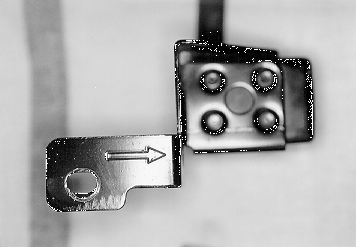 |
Sensor1This is a plan view of a typical airbag sensor housing. These metal cases are mounted by bolts to the radiator frame. Note the housing has a directional arrow impressed upon it to indicate a mounting direction. The dimensions of the case are approximately 1.5 inches in depth by 2.5 inches in length and 1.75 inches in width. The cable visible is mounted to a circuit board at the rear of the sensor. This sensor was removed from a newer Ford sedan.
|
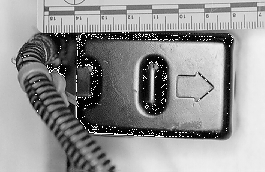 |
Sensor 2This picture shows a different type of airbag sensor casing. This is out of an import product, but was mounted in a similar location and fashion to Sensor 1 above. Some housings were bolted on using Torx head fasteners. This of course requires a specific Torx tool for removal. The directional mounting arrow is again evident. |
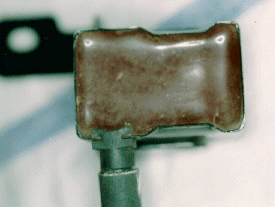 |
Sensor 3This is the underside of sensor 1. Apparent in the photograph is the epoxy filler that encases the ball-in-tube accelerometer. The chemical make up of this filler is different from the epoxy used for sensor2. The primary function of the epoxy is to hold the accelerometer in place and to weather proof the system. |
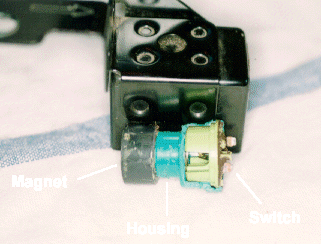 |
Sensor 4This image shows a mechanical ball in tube type sensor in front of the casing. The system works in a particular direction. The cut-away of the actual sensor shows the magnet, the black cylinder toward the rear of the sensor; the housing for the ball mass and the arms of the switch mechanism. |
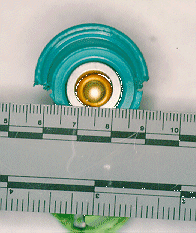 |
Sensor 5This is a top view looking down the tube of the ball in tube sensor. The sphere in the center is the gold plated ball that is held in place magnetically. Should an acceleration of sufficient force, and in the proper direction occur, the magnetic force is overcome by the inertial force of the gold ball. The ball travels forward in the tube and makes contact with the switch placed ahead of it about 7 mm (1/4 inch). This contact closes the circuit and allows a current to flow to the control module which indicates a fire (deploy) command. |
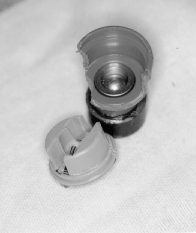 |
Sensor 6This cut-away shows ball in place in the tube housing and the upside-down cap. |
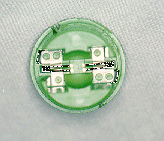 |
Sensor 6This image shows the rear portion of the metal arms on either side of the medial plane. When a collision of great enough magnitude occurs the gold ball travels forward enough to contact the arms and close the switch, sending a signal to the diagnostic module to arm the system. |
Ed Phillips was a police officer for the City of Vacaville, California from 1979 - 1987. In 1987 he accepted a position as an Investigator with the County of San Diego Engineering section.
The position provides on-scene documentation through total station survey and photography of traffic collisions involving severe injuries and death. The entire County population is over 3 million residents, and the County maintains over 1,800 miles of roadways. Mr. Phillips has investigated hundreds of fatal collisions during his time with the County. He is used as a consultant for allied agencies, County Counsel and the District Attorneys' Office.
Mr. Phillips has consulted with Law Firms through out the western United States as well as the State Attorney Generals Office and the Department of Transportation.
Mr. Phillips holds Bachelor Degrees in Criminal Justice and Engineering (Manufacturing) and has attended many hundreds of hours of specific technical training in the field of collision reconstruction.
He can be contacted at [email protected]
|
Copyright ©
|